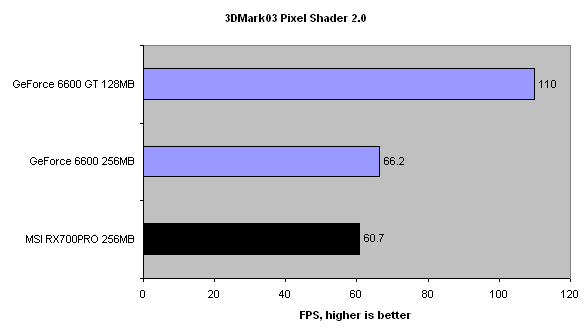Fillrate and shading
I've shied away from discussing the RX700PRO-256's technical attributes thus far.| Card | MSI RX700PRO | Galaxy GeForce 6600 | GeForce 6600 GT |
| Manufacturing process | 110nm | 110nm | 110nm |
| Interface | PCI-Express (X16) | PCI-Express (X16) | PCI-Express (X16) |
| Render setup | 8x1 | 8x1 | 8x1 |
| Onboard memory | 256MB | 256MB | 128MB |
| Core speed | 425MHz | 325MHz | 500MHz |
| Multi-texture fillrate | 3400MTexels/s | 2600MTexels/s | 2000MTexels/s |
| Memory speed | 864MHz | 550MHz | 1000MHz |
| Memory bus width | 128-bit | 128-bit | 128-bit |
| Memory bandwidth | 13.8GB/s | 8.8GB/s | 16GB/s |
| Estimated price | £155 | £125 | £155 |
| Vertex shaders | 6 | 3 | 3 |
Thinking of it in relation to an R423 (PCIe X800) part, we see that it has half the basic rendering power of the full 16-pipe part. Two quad units instead of four. Another performance chop is delivered by only using half an R423's 256-bit memory bus, which generally reduces available bandwidth by half on a memory clock-for-clock basis. What's surprising, however, is that a further chop hasn't been made in vertex shading ability. The X700 PRO retains the X800's 6 vertex shaders. That's impressive for a midrange part. As a comparison, GeForce 6600s, which are direct competition with X700s, run with only 3 vertex shaders. They also use an equivalent 8-pipe rendering setup and a 128-bit memory bus. It all looks too close to call on paper.
Talking of fillrate and shading power, let's see how 3DMark03 sees it.

Single-texturing fillrate is where we would expect it given the core speeds, right between the GeForce 6600/6600 GT.

The common scenario of multi-texturing shows the RX700 to be a little inefficient compared to both GeForce cards. 87% efficiency against the 6600 GT's 97%.

Vertex shading is predictably impressive. 6 shaders operating at 425MHz gives an average framerate of over 30FPS.

Results from the Pixel Shader 2.0 test are less impressive, though. It's almost half as slow as a 6600 GT and even falls behind a slower, cheaper 6600. An interesting set of results that should make real-world benchmarks hard to predict.









